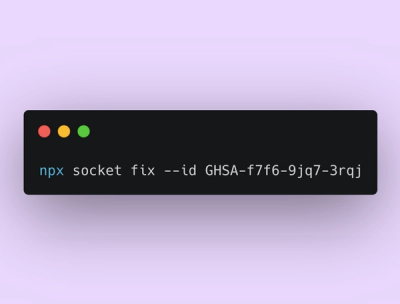
Product
Announcing Socket Fix 2.0
Socket Fix 2.0 brings targeted CVE remediation, smarter upgrade planning, and broader ecosystem support to help developers get to zero alerts.
The simplest no-nonsense progress bar for python.
lowbar is a blazing fast module with zero dependencies for displaying a progress bar in the terminal. It has a low number of features and a simple codebase, hence the name lowbar.
\n and carriage return \r.Install the latest stable release:
pip install lowbar
Or the development version:
pip install git+https://github.com/AnnikaV9/lowbar
Once you have lowbar installed, you can import it like any other module:
from lowbar import lowbar
And initialize the bar:
bar = lowbar()
To make the bar visible and set at 0%:
bar.new()
After completing some tasks, we can increase the bar's completion percentage:
bar.add(20)
If we have a known number of tasks, lowbar can automatically calculate the percentage for us:
bar.next(n_tasks)
[!NOTE] If you set the number of tasks when initializing lowbar with
lowbar(n_tasks), you don't need to passn_taskstonext().
We can also set the completion percentage instead of adding to it:
bar.update(50)
Using print() or other similar functions will push the bar up, which doesn't look nice. To log messages without affecting the bar:
bar.log("Hello World!")
And finally, to clear the bar completely:
bar.clear()
Here's an example usage of the bar:
bar = lowbar(10)
bar.new()
for i in range(10):
time.sleep(0.5) # task
bar.log(f"Task {i+1} completed")
bar.next()
bar.clear()
print("Tasks complete!")
You don't even need a loop:
bar.new()
time.sleep(0.5) # task
bar.add(10)
time.sleep(0.5) # task
bar.add(10)
time.sleep(0.5) # task
bar.update(100)
bar.clear()
print("Tasks complete!")
The bar can also be used with a context manager. It will automatically run new() at the start and clear() when exiting:
with lowbar(2) as bar:
time.sleep(0.5) # task
bar.next()
time.sleep(0.5) # task
bar.next()
print("Tasks complete!")
To make things simpler, you can wrap lowbar around range() and turn it into an iterable. It will automatically calculate how much to increase the percentage by every loop:
for i in lowbar(range(100)):
time.sleep(0.5) # task
Pass an integer and lowbar will convert it into a range object for you:
for i in lowbar(100):
time.sleep(0.5) # task
[!NOTE] You can't use
log()when using lowbar as an iterable.
You can also change the load fill and blank fill chars:
bar = lowbar(load_fill="O", blank_fill=".")
Or add a description text to the left side of the bar:
bar = lowbar(desc="Downloading...")
[!NOTE] If the console is too small to accommodate both the bar and the description text, the text will be hidden.
See the reference for more details.
All contributions are welcome!
If you wish to report a bug or suggest a feature, open an issue.
You can also make a pull request directly if you already have the fix for a bug.
See CONTRIBUTING.md for guidelines to follow.
Contributors are listed in CONTRIBUTORS.md.
This project is licensed under the MIT License.
FAQs
The simplest no-nonsense progress bar for python.
We found that lowbar demonstrated a healthy version release cadence and project activity because the last version was released less than a year ago. It has 1 open source maintainer collaborating on the project.
Did you know?

Socket for GitHub automatically highlights issues in each pull request and monitors the health of all your open source dependencies. Discover the contents of your packages and block harmful activity before you install or update your dependencies.

Product
Socket Fix 2.0 brings targeted CVE remediation, smarter upgrade planning, and broader ecosystem support to help developers get to zero alerts.

Security News
Socket CEO Feross Aboukhadijeh joins Risky Business Weekly to unpack recent npm phishing attacks, their limited impact, and the risks if attackers get smarter.

Product
Socket’s new Tier 1 Reachability filters out up to 80% of irrelevant CVEs, so security teams can focus on the vulnerabilities that matter.